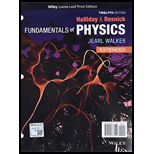
FUNDAMENTALS OF PHYSICS - EXTENDED
12th Edition
ISBN: 9781119773511
Author: Halliday
Publisher: WILEY
expand_more
expand_more
format_list_bulleted
Question
Chapter 32, Problem 25P
To determine
To find:
a) Magnitude of magnetic field at distance
b) The rate of change of electric field,
Expert Solution & Answer
Want to see the full answer?
Check out a sample textbook solution
Students have asked these similar questions
3
Set
ба
||Axl
49.32
6b
71
Ay
22
Magnitude of A
Angle of A
24.04
Angle of -A
22
54
155.96
° (pos Ax) 204.04
° (neg Ax) 335.96
°
(pos Ax)
° (neg Ax)
115.77
° (pos Ax) 295.77
° (pos Ax)
-39
81
208.78
° (neg Ax) 28.78
°
(neg Ax)
3AA . not sure what i am getting wrong
Chapter 32 Solutions
FUNDAMENTALS OF PHYSICS - EXTENDED
Ch. 32 - An electron in an external magnetic field Bext has...Ch. 32 - Prob. 1PCh. 32 - Prob. 3PCh. 32 - Prob. 5PCh. 32 - Prob. 11PCh. 32 - Prob. 12PCh. 32 - Prob. 13PCh. 32 - Prob. 14PCh. 32 - Prob. 15PCh. 32 - Prob. 16P
Ch. 32 - Prob. 17PCh. 32 - Prob. 25PCh. 32 - Prob. 26PCh. 32 - Assume the average value of the vertical component...Ch. 32 - In New Hampshire the average horizontal component...Ch. 32 - SSM WWWIf an electron in an atom has an orbital...Ch. 32 - Prob. 34PCh. 32 - What is the measured component of the orbital...Ch. 32 - Prob. 36PCh. 32 - Assume that an electron of mass m and charge...Ch. 32 - Prob. 41PCh. 32 - Prob. 42PCh. 32 - Prob. 43PCh. 32 - You place a magnetic compass on a horizontal...Ch. 32 - SSM ILW WWW The magnitude of the magnetic dipole...Ch. 32 - The magnitude of the dipole moment associated with...Ch. 32 - SSMThe exchange coupling mentioned in Module 32-8...Ch. 32 - Prob. 50PCh. 32 - Prob. 51PCh. 32 - Prob. 52PCh. 32 - Prob. 53PCh. 32 - Using the approximations given in Problem 61, find...Ch. 32 - Earth has a magnetic dipole moment of 8.0 1022...Ch. 32 - A charge q is distributed uniformly around a thin...Ch. 32 - A magnetic compass has its needle, of mass 0.050...Ch. 32 - Prob. 58PCh. 32 - Prob. 59PCh. 32 - SSMThe magnetic field of Earth can be approximated...Ch. 32 - Prob. 62PCh. 32 - Prob. 63PCh. 32 - A sample of the paramagnetic salt to which the...Ch. 32 - Prob. 65PCh. 32 - What is the measured component of the orbital...
Knowledge Booster
Similar questions
arrow_back_ios
SEE MORE QUESTIONS
arrow_forward_ios
Recommended textbooks for you
 Physics for Scientists and Engineers: Foundations...PhysicsISBN:9781133939146Author:Katz, Debora M.Publisher:Cengage Learning
Physics for Scientists and Engineers: Foundations...PhysicsISBN:9781133939146Author:Katz, Debora M.Publisher:Cengage Learning
 Principles of Physics: A Calculus-Based TextPhysicsISBN:9781133104261Author:Raymond A. Serway, John W. JewettPublisher:Cengage Learning
Principles of Physics: A Calculus-Based TextPhysicsISBN:9781133104261Author:Raymond A. Serway, John W. JewettPublisher:Cengage Learning Glencoe Physics: Principles and Problems, Student...PhysicsISBN:9780078807213Author:Paul W. ZitzewitzPublisher:Glencoe/McGraw-Hill
Glencoe Physics: Principles and Problems, Student...PhysicsISBN:9780078807213Author:Paul W. ZitzewitzPublisher:Glencoe/McGraw-Hill Physics for Scientists and Engineers, Technology ...PhysicsISBN:9781305116399Author:Raymond A. Serway, John W. JewettPublisher:Cengage Learning
Physics for Scientists and Engineers, Technology ...PhysicsISBN:9781305116399Author:Raymond A. Serway, John W. JewettPublisher:Cengage Learning Physics for Scientists and EngineersPhysicsISBN:9781337553278Author:Raymond A. Serway, John W. JewettPublisher:Cengage Learning
Physics for Scientists and EngineersPhysicsISBN:9781337553278Author:Raymond A. Serway, John W. JewettPublisher:Cengage Learning

Physics for Scientists and Engineers: Foundations...
Physics
ISBN:9781133939146
Author:Katz, Debora M.
Publisher:Cengage Learning


Principles of Physics: A Calculus-Based Text
Physics
ISBN:9781133104261
Author:Raymond A. Serway, John W. Jewett
Publisher:Cengage Learning

Glencoe Physics: Principles and Problems, Student...
Physics
ISBN:9780078807213
Author:Paul W. Zitzewitz
Publisher:Glencoe/McGraw-Hill

Physics for Scientists and Engineers, Technology ...
Physics
ISBN:9781305116399
Author:Raymond A. Serway, John W. Jewett
Publisher:Cengage Learning

Physics for Scientists and Engineers
Physics
ISBN:9781337553278
Author:Raymond A. Serway, John W. Jewett
Publisher:Cengage Learning